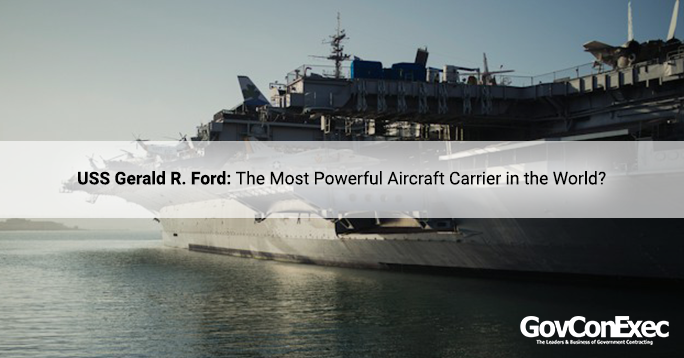The first-in-class USS Gerald R. Ford exemplifies the U.S. Navy’s generational leap in global power projection. With its outstanding engineering, powerful capabilities, and enormous size, the USS Gerald R. Ford undoubtedly dominates other aircraft carriers.
However, what exactly is the USS Gerald R. Ford’s power level? Let’s find out as we unveil everything you need to know about the Navy’s premier aircraft carrier.
About USS Gerald R. Ford
USS Gerald R. Ford (CVN 78) is the lead ship in the Ford-class aircraft carriers of the U.S. Navy. The CVN 78 is a nuclear-powered carrier with new EMALS and AAG features.
The ship’s name was dedicated to the former president Gerald R. Ford, the 38th president of the United States. The decision celebrates and recognizes his years of service to the Navy, the government, and the nation.
Here is the overview of USS Gerald R. Ford’s class features.
- Manufacturer: Huntington Ingalls Industries Newport News Shipbuilding
- Type: Nuclear-powered aircraft carrier
- Length: 333 meters
- Beam: 40.8 meters
- Flight Deck Width: 78 meters
- Armament: Evolved Sea Sparrow Missile, Rolling Airframe Missile, CIWS
- Propulsion: Two nuclear reactors, four shafts
USS Gerald R. Ford: The Making of the U.S. Navy’s Largest Aircraft Carrier
The Navy hadn’t introduced a new generation of aircraft carriers for almost 40 years—until the CVN 78 came. Making the USS Gerald Ford was a combination of efforts from HII Newport News Shipbuilders and Northrop Grumman. Below is a brief timeline of the making of USS Gerald R. Ford.
- November 14, 2009 – HII and the U.S. Navy representatives formally recognized and attended the ship’s construction.
- November 9, 2013 – Susan Ford-Bales, the daughter of Gerald R. Ford, led the christening ceremony. This is when the vessel was first launched into the water.
- July 22, 2017 – Former President Donald J. Trump led the commissioning ceremony of CVN 78. It marked its availability in the Naval service.
- July 28, 2017 – Lt. Cmdr. Jamie Struck piloted the first trap or fixed-wing aircraft landing.
- March 29, 2022 – The ship finished its flight deck and carrier air traffic control center certifications.
In a CNN report from January 2, 2024, the aircraft carrier returned from the eastern Mediterranean Sea to Norfolk, Virginia. The 2023 Hamas-Israel conflict marked the first combat deployment of CVN 78.
USS Gerald R. Ford’s notable design features
USS Gerald R. Ford is, by far, the world’s largest and most powerful aircraft carrier. As it’s the newest ship in the fleet, it is also the most advanced among the Ford-class aircraft carriers. Let’s look at the advanced features of CVN 78.
Electromagnetic Aircraft Launch System (EMALS)
The Navy has developed EMALS, a state-of-the-art launch system specifically used for the USS Gerald R. Ford. EMALS enables the new ship to operate with an electromagnetic catapult.
EMALS launches aircraft from the decks of the aircraft carrier using electromagnetic technology. This more modern system has replaced traditional steam catapults, making acceleration smoother and less stressful when launching planes. It also increased the sortie rate to 33% (160 sorties/day), which is higher than the previous model, Nimitz-class carriers.
Advanced Arresting Gear (AAG)
AGG is another system developed for the U.S. Navy’s new aircraft carriers, including the CVN 78. This technology employs energy-absorbing water turbines and a computerized control system for safe and efficient airplane arrest landings. It helps aircraft to quickly decelerate when landing.
Nuclear Propulsion
Like other Navy aircraft carriers, the USS Gerald R. Ford is powered by nuclear reactors. The propulsion has two reactors, four shafts, and a zonal electrical power distribution system.
Under the DoD contract with Northrop Grumman, an advanced nuclear propulsion system powers the ships. The first award worth $107.6 million was made in July 2003. The second contract worth $1.39 billion was finalized in May 2004. In 2004, the DoD awarded another $559 million contract to prepare the carrier’s construction plans for the ship’s propulsion system.
Related article: Northrop Grumman, Mitsubishi Electric Partner to Improve Japan’s Defense Capabilities
Advanced Radar and Combat Systems
The USS Gerald R. Ford implements cutting-edge radar and fighting systems. The enhanced radar and combat systems provide outstanding situational awareness and defense capabilities.
In April 2020, the U.S. Navy organized a department for CVN 78’s combat systems testing. The combat systems department oversaw the sea-based developmental testing (SBDT), carrying out trials on the ship’s combat system capabilities. It includes the Dual Band Radar with Rolling Airframe Missile and Sea Sparrow missiles check.
Improved Automation
The efficient operations of the ships in the Ford class are made possible by its advanced automation technologies. CVN 78 has new electronics, computing, and onboarding power generation capacities. The newer computer automation of the USS Gerald Ford can minimize the workload and reduce the crew size.
Enhanced Flight Deck
The Ford-class carriers’ flight decks are better equipped than their predecessors. With a 337m long, 78m wide flight deck, more aircraft can take off and land in less time.
Integrated Warfare Systems
The CVN 78 has an integrated system for air defense, anti-submarine warfare, and surface warfare. It is a robust and flexible platform for maritime activities.
How the USS Gerald R. Ford improved the U.S. Navy’s operations
The USS Gerald R. Ford’s capabilities make it a significant asset for supporting many military activities and wartime objectives. Given its advanced features, the USS Gerald R. Ford has improved Navy operations.
Enhanced operational efficiency
Advanced automation systems, EMALS, and AAG of CVN 78 improved the operational and mission effectiveness of CVN 78. It significantly contributes to the overall efficiency of the U.S. Navy during combat and operations.
Reduced crew size for cost-effective operations
The CVN 78 has advanced automated systems, allowing a smaller crew to operate the ship. Reducing the number of people also means decreasing the overhead budget.
Approximately 700 fewer crew members are needed for the USS Gerald R. Ford to sail than a USS Nimitz-class ship. The CVN 78’s advanced features enable the vessel to work efficiently even with reduced crew size.
Enhanced durability to withstand extended missions
The Ford-class carriers’ modern radar, combat systems, structural design, and damage control increase the survivability rate in combat situations. The CVN 78 is also expected to have a 50-year service life.
While testing the Ford-class carrier, it survived three 40,000-pound underwater explosives released close to the ship. Shock trials showed the ship’s shock durability and ability to maintain operations in actual battle.
Demonstrate the power projection capability of the Navy
The mighty aircraft carrier provides power projection. Its vast build can be seen across vast distances, showing its strength and possibly intimidating enemies.


